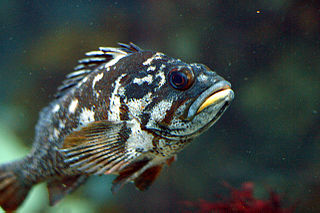
Sebastinae is a subfamily of marine fish belonging to the family Scorpaenidae in the order Scorpaeniformes. Their common names include rockfishes, rock perches, ocean perches, sea perches, thornyheads, scorpionfishes, sea ruffes and rockcods. Despite the latter name, they are not closely related to the cods in the genus Gadus, nor the rock cod, Lotella rhacina.
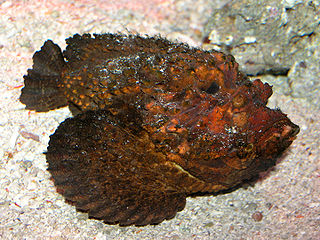
Synanceiinae is a subfamily of venomous ray-finned fishes, waspfishes, which is classified as part of the family Scorpaenidae, the scorpionfishes and their relatives. These fishes are found in the Indo-Pacific oceans. They are primarily marine, though some species are known to live in fresh or brackish waters. The various species of this family are known informally as stonefish, stinger, stingfish and ghouls. Its species are known to have the most potent neurotoxins of all the fish venoms, secreted from glands at the base of their needle-like dorsal fin spines. The vernacular name, stonefish, for some of these fishes derives from their behaviour of camouflaging as rocks. The type species of the family is the estuarine stonefish.

Anthias are members of the family Serranidae and make up the subfamily Anthiinae. The name Anthiidae is preoccupied by a subfamily of ground beetles in the family Carabidae created by Bonelli in 1813 and this grouping should be called the Anthiadinae. However, both the 5th Edition of Fishes of the World and Fishbase give the Serranid subfamily as "Anthiinae".

Trichogaster is a genus of gouramis native to South Asia from Pakistan to Myanmar. It is the only genus in the monotypic subfamily Trichogastrinae as set out in the 5th Edition of Fishes of the World, although that book states that there are two genera, the other being Colisa which is treated as a synonym of Trichogaster by Fishbase and the Catalog of Fishes. Fishbase also places the genus in the Luciocephalinae. Species of this genus are very popular in the aquarium trade.

Setarchinae, the deep-sea bristly scorpionfishes, is a small subfamily of deep-sea ray-finned fishes, it is part of the family Scorpaenidae. They are small marine fishes, growing up to 25 cm, and are found in tropical and subtropical waters throughout the world.

Apistinae, the wasp scorpionfishes, is a subfamily of venomous, marine ray-finned fishes belonging to the family Scorpaenidae, the scorpionfishes and related species. These fishes are native to the Indian Ocean and the western Pacific Ocean.

Caranginae is a subfamily of ray-finned fish from the family Carangidae which consists of twenty genera and 103 species.
Pteroini is a tribe of marine ray-finned fishes, one of two tribes in the subfamily Scorpaeninae. This tribe includes the lionfishes, sawcheek scorpionfishes and turkeyfishes. The taxonomy of the scorpionfishes is in some flux; the 5th Edition of Fishes of the World treats this taxa as a tribe within the subfamily Scorpaeninae of the family Scorpaenidae within the order Scorpaeniformes, while other authorities treat it as a subfamily within a reduced family Scorpaenidae within the suborder Scorpaenoidei, or the superfamily Scorpaenoidea within the order Perciformes.

Tincinae is a subfamily of freshwater ray-finned fish from the family Cyprinidae, it consists of the tench of Eurasia and the east Asian clod minnows.
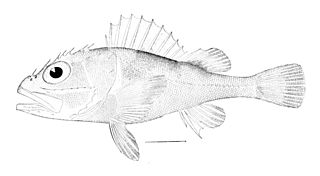
Trachyscorpia is a genus of marine ray-finned fish belonging to the subfamily Sebastinae, the rockfishes, part of the family Scorpaenidae. The species in this genus are found in the Atlantic, Indian and Pacific oceans.

Cypsellurinae is a subfamily of flying fishes, one of four in the family Exocoetidae and the only one which is not monogeneric.

Trachinotinae is a subfamily of the family Carangidae, the jacks and pompanos.
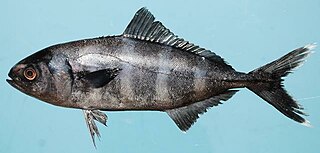
Naucratinae is a subfamily of ray-finned fish from the family Carangidae which consists of five genera and 13 species.

Luciocephalinae is a subfamily of the gourami family Osphronemidae. The members of this subfamily differ from the other groups within the gourami family by having a reduced number of rays supporting the branchiostegal membrane, five rather than six, and in the possession of a median process of the basioccipital which reaches the first vertebra and which has an attachment to the Baudelot's ligament.
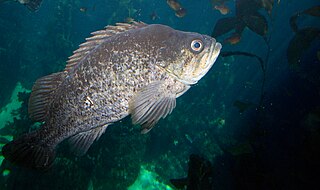
Sebastini is a tribe of marine ray-finned fishes belonging to the subfamily Sebastinae of the family Scorpaenidae in the order Scorpaeniformes.

Apodichthyinae is a subfamily of marine ray-finned fish belonging to the family Pholidae, the gunnels. These fishes are found in the North Pacific Ocean.
Lumpeninae is a subfamily of marine ray-finned fishes, classified within the family Stichaeidae, the pricklebacks or shannies. These fishes are found in the North Pacific, Arctic and North Atlantic Oceans.

Chirolophinae is a subfamily of marine ray-finned fishes, classified within the family Stichaeidae, the pricklebacks or shannies. These fishes are found in the North Pacific, Arctic and North Atlantic Oceans.
Neozoarcinae is a subfamily of marine ray-finned fishes, classified within the family Stichaeidae, the pricklebacks or shannies. These fishes are found in the North Pacific Ocean.

Hypsagoninae is a subfamily of marine ray-finned fishes belonging to the family Agonidae, part of the sculpin superfamily Cottoidea. These fishes are found in the North Pacific Ocean.

















